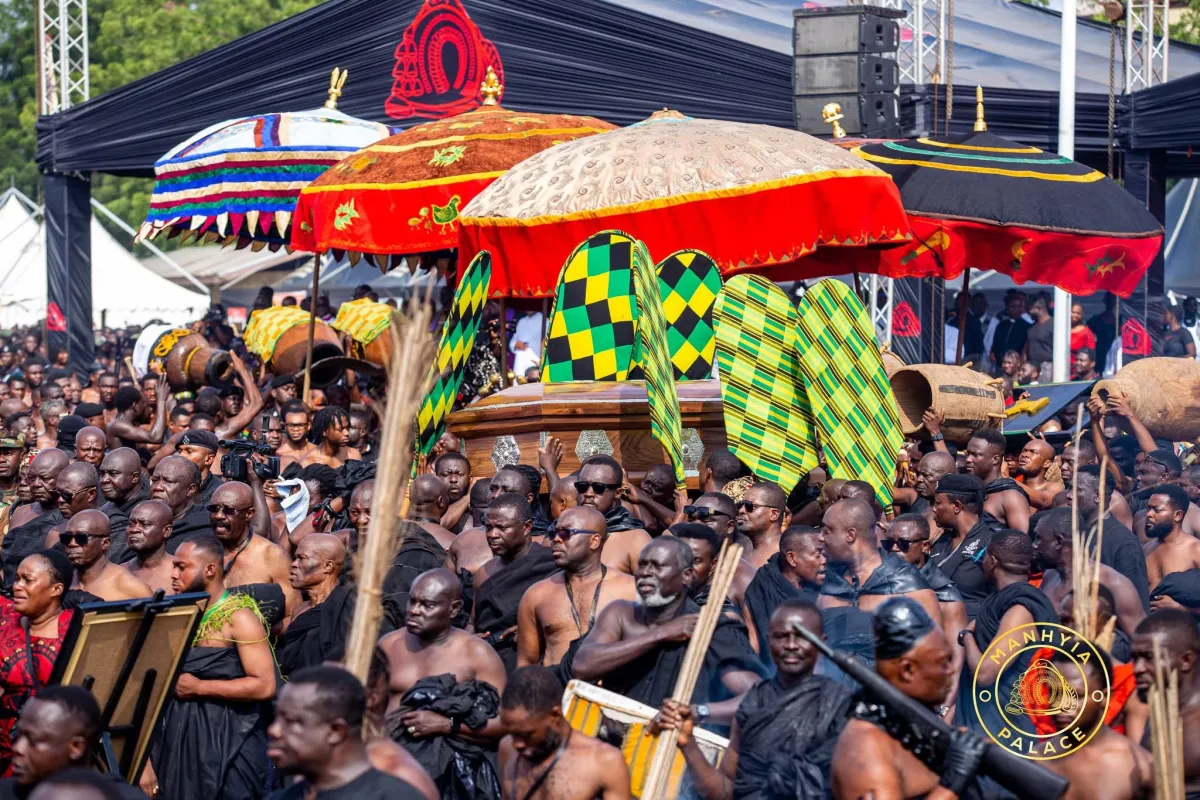By Henrietta Afful,Nana Karikari
Copyright gbcghanaonline

By: Nana Karikari, Senior Global Affairs Correspondent
The final funeral rites for the late Asantehemaa, Nana Konadu Yiadom III, have concluded, but the powerful messages and cultural significance of the event will resonate for a long time. The four-day traditional burial, or Doteyie, was more than just a tribute; it was a profound demonstration of the enduring strength of the Asante Kingdom and its deep connection to the Ghanaian people. The unprecedented voluntary compliance with the regional “lockdown” speaks volumes about the reverence for traditional authority and the unifying role of the monarchy in a modern democratic state. This wasn’t a state-enforced curfew; it was a collective act of solidarity and respect. It showed the world that in Ghana, traditional power and modern governance can coexist, with one often bolstering the other.
The Historical Weight of the Golden Stool
To fully understand the gravity of this event, one must first grasp the historical significance of the Ashanti Kingdom. Emerging in the 17th century, the Ashanti Empire was one of the most powerful pre-colonial states in West Africa. At its heart lies the Golden Stool, or ‘Sika Dwa Kofi’, a sacred symbol believed to contain the soul of the Ashanti people. This stool is not just a ceremonial throne; it represents the collective strength and identity of the kingdom. It was this unified power that allowed the Ashanti to successfully resist the British for over a century, culminating in the famous Yaa Asantewaa War of 1900. While no longer an empire, the Ashanti Kingdom remains a formidable political and cultural force in modern Ghana, with its influence extending far beyond its ethnic boundaries. The reverence shown during the funeral is a direct reflection of this deep historical legacy.
A Legacy of Dignity and Care
The tributes to the late Asantehemaa, Nana Konadu Yiadom III, painted a picture of a leader who redefined royalty. Rather than an inaccessible figure, she was portrayed as a compassionate matriarch. Asantehene Otumfuo Osei Tutu II’s words, “She sat in majesty, yet never placed herself above her people,” capture this perfectly. He described her as “the voice of the woman in the market, the comfort of widows, the guardian of orphans.” This emphasis on service over command, and care over domination, provides a modern lesson in leadership from a traditional institution.
President John Dramani Mahama echoed this sentiment, calling her an “inspiration and a worthy role model” for Ghanaian women. Her reign, though brief at eight years, was marked by her role in preserving Ashanti values and promoting dignity and peace. Her influence transcended the Manhyia Palace, shaping national leadership through her “wise counsel and astute guidance.”
The unique bond between the Asantehene and the Asantehemaa, described by Otumfuo Osei Tutu II as “two shoes, two rows, yet one heart for our people,” is a cornerstone of Ashanti governance. The fact that she was his senior sister strengthened this relationship, highlighting the crucial interplay between personal ties and traditional roles. This dynamic is a powerful example of how tradition can adapt to and be enriched by personal relationships while maintaining its core purpose. The mourning period showed the public’s deep respect for this bond.
The Power of Tradition in a Modern Ghana
The near-total shutdown of Kumasi was a striking display of communal obedience. Despite the economic disruption, residents complied without protest. Businesses closed, schools shut down, and streets emptied as the city gave way to tradition. A taxi driver at the ‘Dr. Mensah’ rank, who was a rarity on the streets, remarked that he was “not disappointed at the ban.” This sentiment was widely shared. Commuters, despite walking long distances, said they didn’t “regret the situation since it was all part of their duty to the Manhyia Palace.” This response from ordinary citizens is perhaps the most significant aspect of the event. It demonstrates that the Ashanti Kingdom is not just a ceremonial entity but a living, breathing force in the lives of its people. This collective act of reverence serves as a reminder of the enduring power of traditional authority in Ghana, coexisting and, at times, overriding the influence of the state.
This event also highlights the role of the Ashanti Kingdom as a unifying force beyond its ethnic boundaries. While the funeral rites were deeply rooted in Ashanti culture, the national tributes from figures like President Mahama underscored her importance to all of Ghana. The event was not just for Asanteman; it was for the entire nation, mourning a “truly remarkable matriarch.” This broad appeal suggests that the Ashanti monarchy holds a unique position, acting as both a cultural anchor for its people and a symbol of national heritage. The public compliance and shared grief across different regions showed a shared national identity connected to these traditions.
The Black Cloth of Grief: A Nation United
Beyond the formal tributes, the sight of Ghanaians across the nation, especially in the Ashanti Region, adorned in red and black was a powerful visual testament to the collective mourning. The tradition of wearing black, the color of grief, symbolizes the somber mood and unity of Asanteman. But for many non-Ashantis who also wore the funeral attire, it was a gesture of national solidarity. This simple act of wearing a specific color of clothing became a powerful, unifying symbol, showing that the passing of a great traditional leader is a national event, not just a regional one. It highlights how cultural traditions can transcend ethnic lines and forge a broader sense of national belonging.
A Tale of Two Cities: Kumasi and Accra
While Kumasi came to a standstill, life in other parts of Ghana, particularly the bustling capital of Accra, continued as normal. This contrast highlights the deep regional reverence for the Ashanti monarchy versus a more detached national perspective. In Kumasi, compliance was seen as a duty. A young man, a student at KNUST, remarked, “It’s a small sacrifice. Her reign brought us peace, and this is our way of saying thank you.” In Accra, however, a market trader, Adwoa, admitted, “I heard about it on the news, but it didn’t really affect me here. It’s a Kumasi thing.” This shows the powerful, localized nature of traditional authority and its varied impact across the country. It sparks a conversation about what it means to be Ghanaian in a country with such diverse and powerful kingdoms, such as the Dagbon Kingdom in the north or the traditional leadership structures of the Ewe people in the Volta Region. It underscores that while each kingdom is distinct, their collective presence is a defining feature of the national identity.
The Economic Ripple Effect
While most people willingly complied with the lockdown, the economic impact was undeniable. The closure of Kejetia Market, often called ‘Kumasi Dubai,’ meant a massive loss of income for countless traders. A woman selling textiles lamented, “I lost a whole day’s profit. But you can’t defy tradition. The ancestors are watching.” Conversely, a few food vendors who stayed open saw a boom in business, as a reduced number of competitors allowed them to “rake in much more income than on a normal day.” This provides a human angle to the economic sacrifice, showing that while some were hit hard, others benefited unexpectedly. The Kumasi Metropolitan Area is home to approximately 2.6 million people, and the complete shutdown of the central business district affected an estimated 80% of businesses for at least one day. This demonstrates a significant, self-imposed economic sacrifice for the sake of cultural reverence, a powerful statement in a nation with a GDP per capita of around $2,500. It highlights the complex and often personal trade-offs that come with honoring tradition.
The Asantehemaa’s Role and What’s Next?
The late Asantehemaa, Nana Konadu Yiadom III, was the 14th holder of the position, which carries immense spiritual and political authority. She was the mother of the entire Ashanti Kingdom and the elder sister of the reigning Asantehene, Otumfuo Osei Tutu II. Her primary roles included serving as the chief advisor to the Asantehene, acting as the royal genealogist, and holding the power to nominate a successor to the Golden Stool. This position is not merely ceremonial; the Asantehemaa is a key decision-maker in the matrilineal system of the Ashanti people, where lineage and inheritance are traced through the mother’s line.
This matrilineal system, known as the Abusua (clan), is the foundation of Ashanti society. The Asantehemaa is the head of the royal family, and her position is considered the spiritual heartbeat of the kingdom. She not only nominates the Asantehene but also holds the power to destool him if he fails in his duties. This unique power dynamic ensures a system of checks and balances where traditional power is not absolute, with the Asantehemaa acting as a crucial mediator and a source of ancestral wisdom.
The passing of Nana Konadu Yiadom III leaves a void. The selection of the next Asantehemaa is a critical process, as the position holds a pivotal role in the kingdom’s governance. According to tradition, the new Asantehemaa is selected from the royal matrilineal line. This choice is made by the Asantehene in consultation with key elders and royals. The search will likely focus on a woman who possesses the qualities celebrated in her predecessor: humility, intelligence, and a deep understanding of Ashanti customs.
The new Asantehemaa’s relationship with the Asantehene will be closely watched, as their bond is a “cornerstone of Ashanti governance.” The focus now shifts from mourning to the future, as the Ashanti Kingdom looks to select a leader who will continue to carry the weight of Asanteman. The future Asantehemaa will have big shoes to fill, but the rich traditions and deep reverence of the Ashanti people provide a strong foundation for the path ahead. The collective mourning and respectful compliance with the funeral rites have not only honored the late Asantehemaa but have also reaffirmed the deep-seated cultural identity and unity of the Ashanti people.
Beyond the Funeral: The Future of Traditional Authority in Ghana
The funeral of Nana Konadu Yiadom III was more than just a historical event; it was a potent reminder of the enduring relevance of traditional institutions in contemporary Ghana. In a rapidly globalizing world, the Ashanti Kingdom and other Ghanaian kingdoms face the challenge of preserving their unique customs while adapting to modern pressures. They continue to play a vital role in local governance, land management, and dispute resolution, often working alongside the state apparatus. This event serves as a powerful case study for the rest of Africa and the world on how ancient traditions can not only survive in a modern democratic state but thrive as a source of national identity and stability. The public’s profound respect for this cultural rite points to a future where traditional authority and modern governance continue to intersect, shaping a distinctly Ghanaian identity. In a world where many societies struggle to reconcile modernity with heritage, the Ashanti Kingdom’s ability to command such collective reverence offers a timeless lesson in the power of culture.



